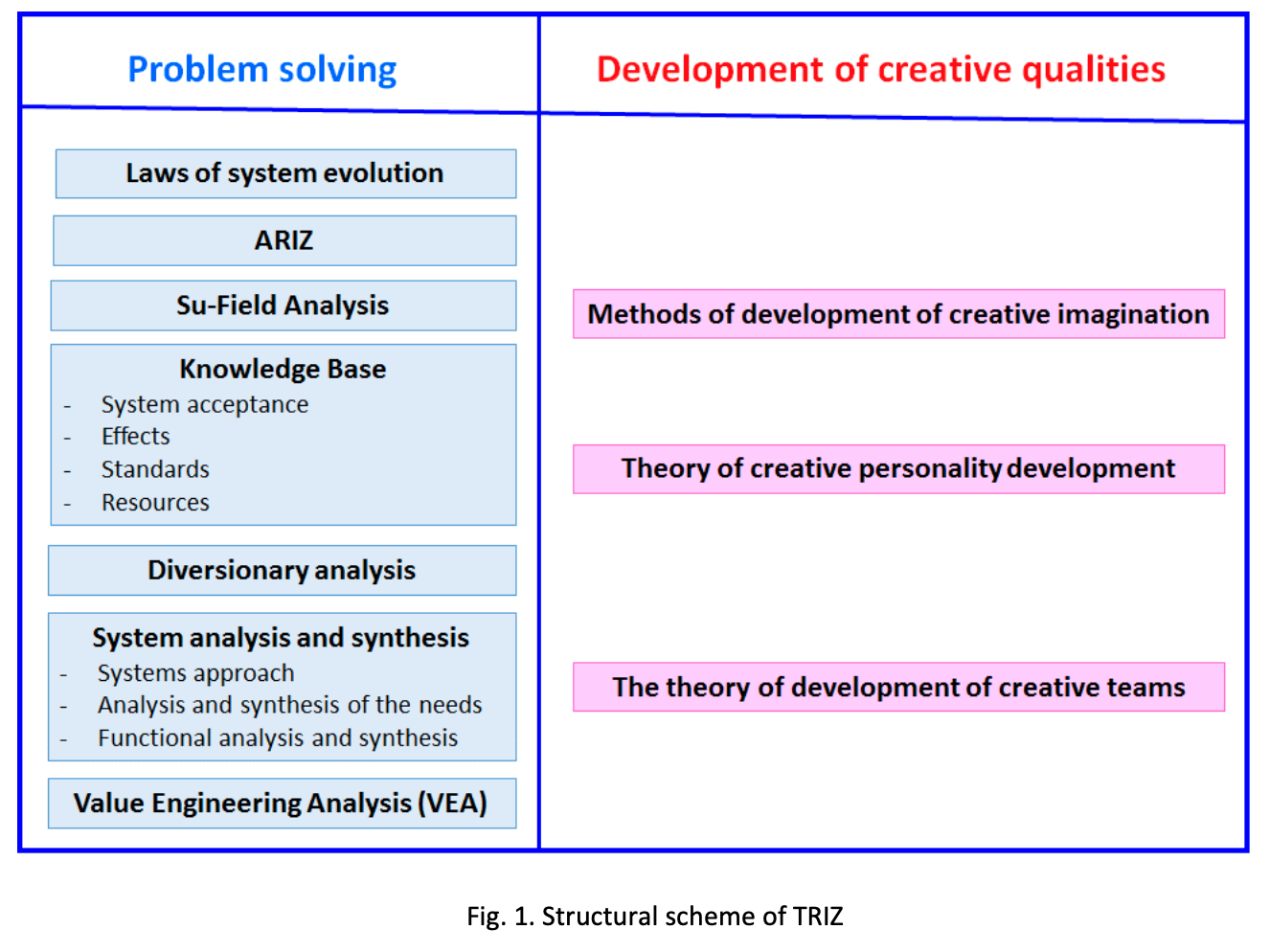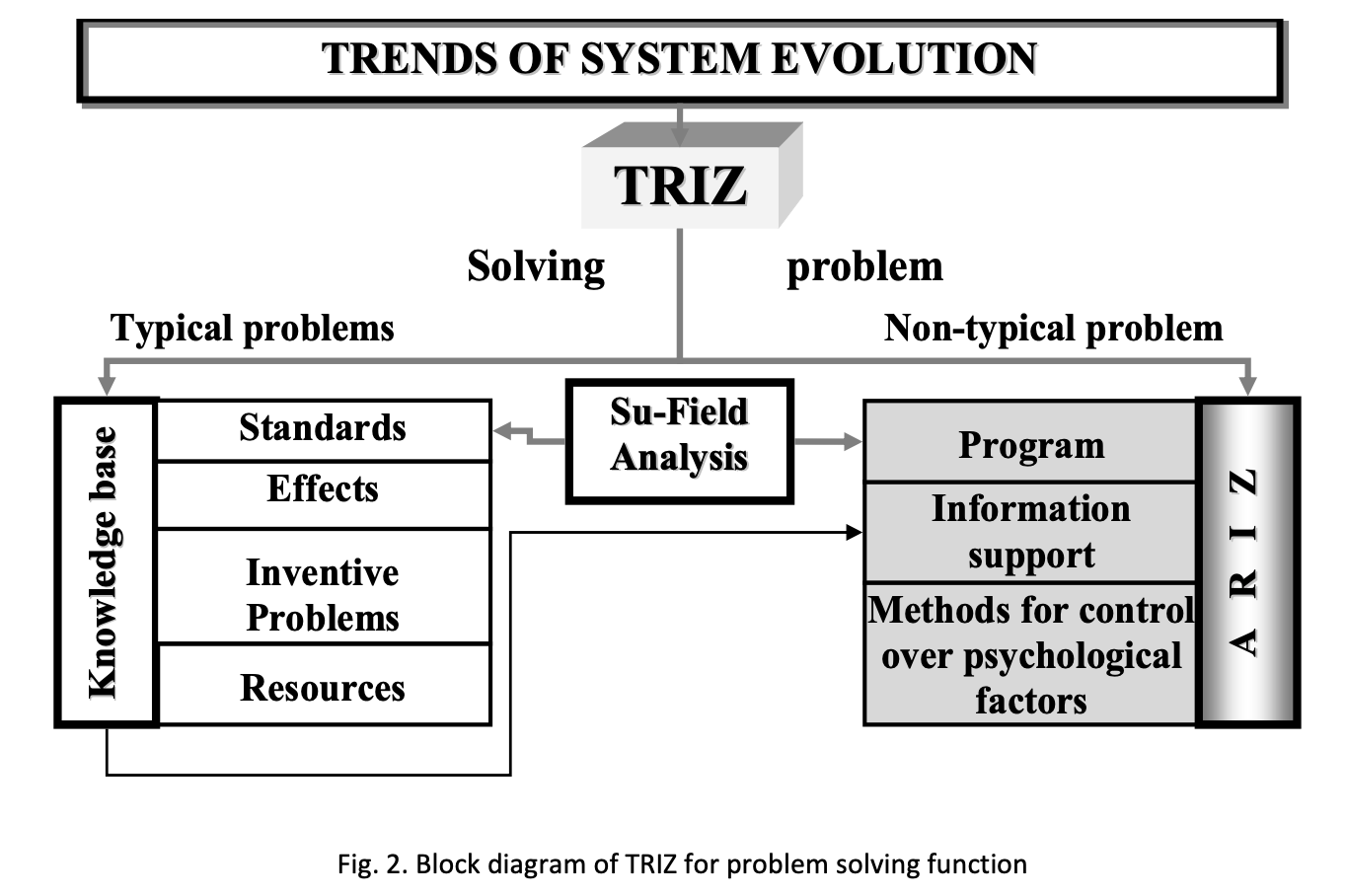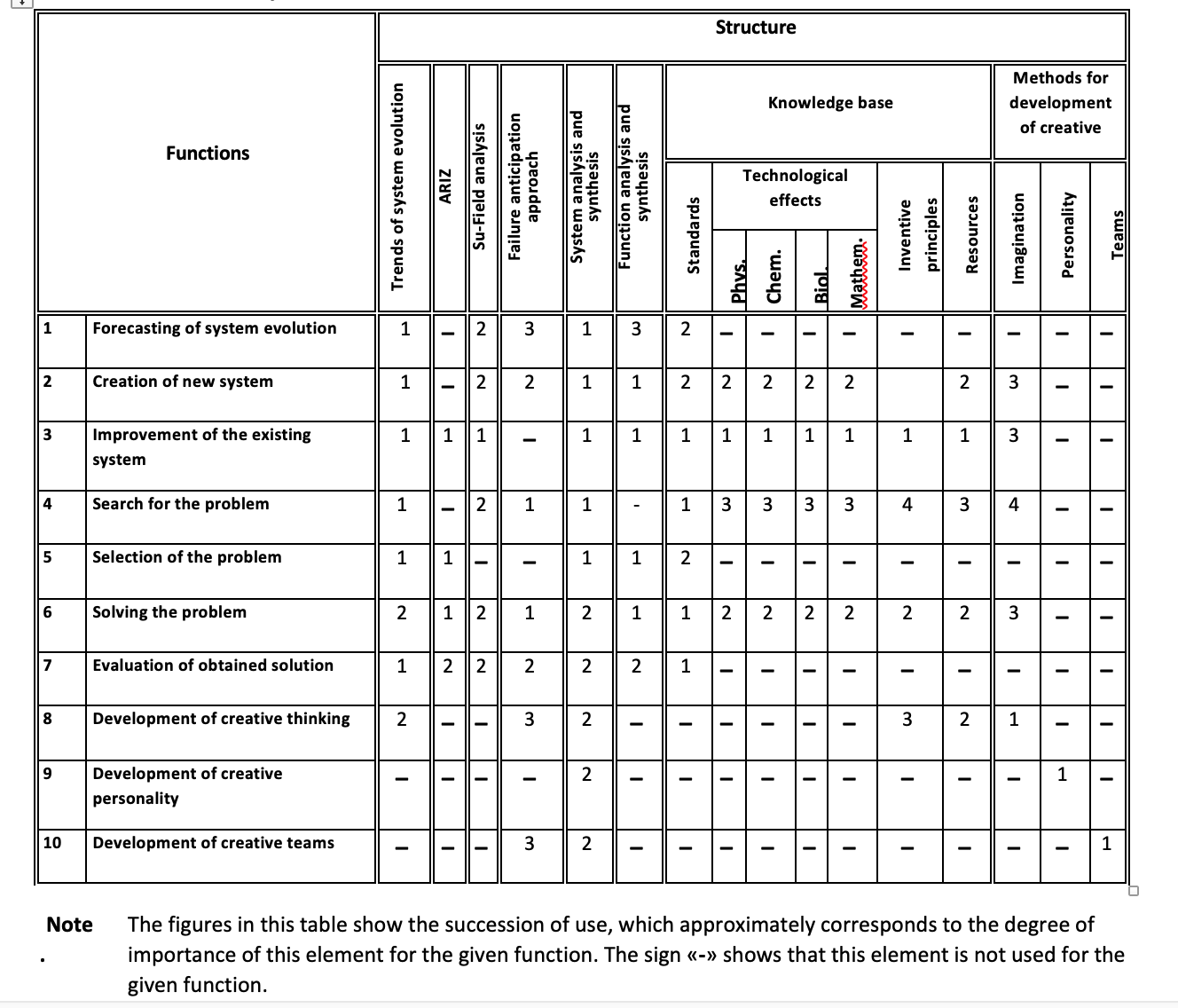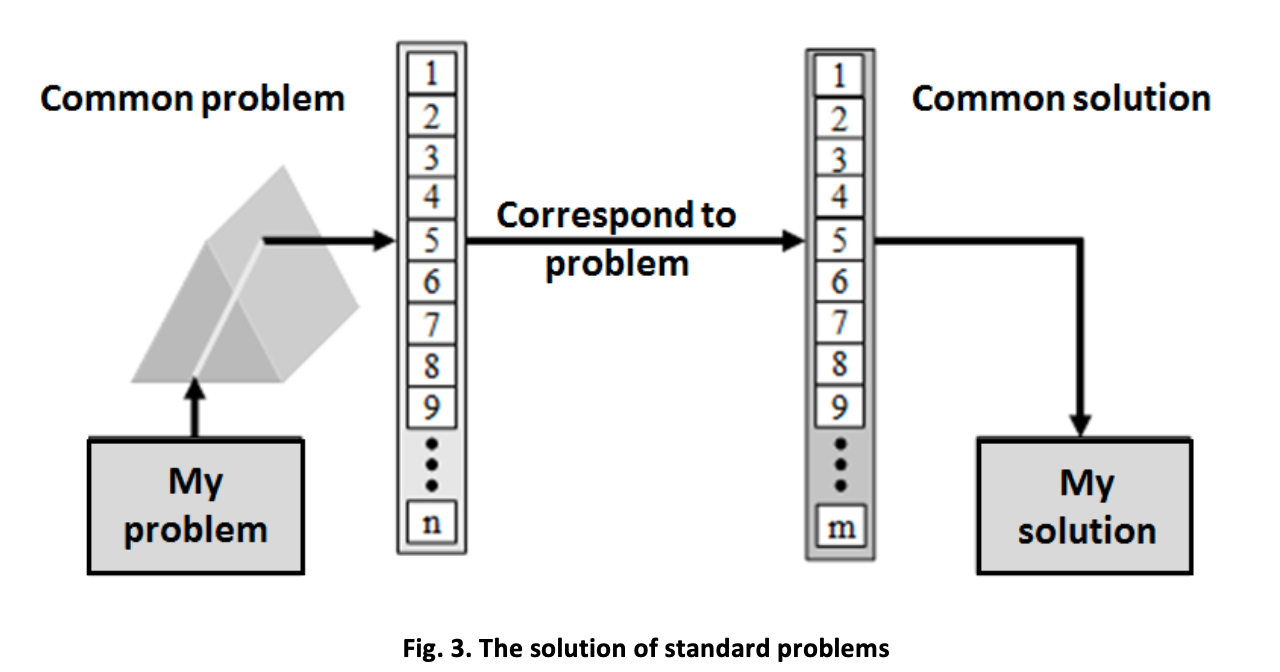 Theory of Inventive Problem Solving (TRIZ) is a technology innovation, in which the creative process is controllable and not chaotic. This technology allows us to solve creative problems; using special laws, practices, policies, and tools.
Theory of Inventive Problem Solving (TRIZ) is a technology innovation, in which the creative process is controllable and not chaotic. This technology allows us to solve creative problems; using special laws, practices, policies, and tools.
Application of TRIZ helps to develop creative (inventive) thinking and creative personality qualities, making it possible to look at objects and phenomena in a new way.
TRIZ is able to find non-trivial, fundamentally new high-level solutions that increase the efficiency of creative work. TRIZ was developed by a Russian scientist and inventor named Genrich Altshuller. He was also a science fiction writer under the pen name of Henry Altov. Altshuller first realized the need to create a technology that enables us to abandon the method of “trial and error” and guides us towards seeking a solution.
 G. S. Altshuller analyzed tens of thousands of patents and formulated the basic TRIZ postulates:
G. S. Altshuller analyzed tens of thousands of patents and formulated the basic TRIZ postulates:
- Technology develops naturally. The laws of technological system evolution are used in solving problems and developing systems
- Any inventive problem can be classified in accordance with the type of problem along with selection of the type of solution
- In order to solve complex inventive problems, it is necessary to identify and resolve the contradiction that is embedded in the problem
TRIZ postulates that there is a fundamental difference between routine thinking and inventive thinking.
While routine thinking is finding a compromise i.e. improvement in some parameters at the expense of others; the inventive thinking reveals the contradiction that is embedded in the problem. The root causes that give rise to this contradiction is determined by deepening and exacerbating the contradiction. We get the results without the disadvantages by resolving the contradiction.
TRIZ functions
The main functions of TRIZ:
- Derive solutions for creative and inventive problems with any degree of complexity and orientation, without exhaustive search for alternatives
- Forecasting the evolution of technological systems (TS) and obtaining promising (including fundamentally new) solutions
- Development of creative human qualities (creative imagination and thinking, creative personality characteristics, creative communities)
TRIZ allows you to:
- identify and eliminate “bottlenecks”
- reduce the cost of products and technologies
- improve the quality of consumer products
- identify and eliminate the causes of failures and harmful effects
TRIZ structure
The main sections of TRIZ:
- Laws of technological system evolution
- TRIZ) Knowledge Base
- Su-Field Analysis (structured substance-field analysis) of technological systems
- Algorithm of Inventive Problem Solving – ARIZ
- Method for detecting and predicting failures and harmful effects (“sabotage analysis”)
- System analysis and synthesis methods
- Value Engineering Analysis (VEA)
- Techniques for development of creative imagination
- Theory of creative personality development
- Theory of development of creative communities
All sections of TRIZ can be divided into two parts: problem solving methods and development of creative quality techniques. The problem solving methods are related to sections 1-7, and development of creative quality techniques are related to section 8-10. The structure of TRIZ according to its classification scheme is shown in Fig. 1. VEA in modern TRIZ is not used alone. It is included in methods of analysis and synthesis of systems, and thus VEA is not shown in Fig. 1.
A simplified block diagram of TRIZ for problem solving function is shown in Fig. 2. Each of the parts of TRIZ is briefly described.
The laws of technological system evolution are the most common statistical patterns and trends in the evolution of technology, identified as a result of patent collection and analysis of the history of technology development.
Knowledge base includes:
- System of standards for inventive problem solving i.e. standard solutions for a certain class of problems
- Engineering Effects:
- Physical effects
- Chemical effects]
- Biological effects]
- Mathematical effects
- Most developed is geometry
- Use of tables
- Methods to eliminate contradictions and application of tables
- Methods of resolving technical contradictions
- 40 inventive principles
- 10 additional.
- Techniques for resolving physical contradictions.
- Techniques – anti-techniques.
- Methods, divided into groups.
- Ways of resolving physical contradictions.
- The resources from nature and technology and how to use them.
Knowledge base is often used in solving problems which are analogous. The solved problem is based on a specific contradiction. Technological Effects are also referred to as scientific effects or simply the effects.
ARIZ consists of an algorithm (sequence of actions) to expose and resolve contradictions, i.e. solution of problem. ARIZ includes: the algorithm itself, information support which is supplied by the knowledge base (as shown by arrow in Figure 2.3), and methods for control of psychological factors, which form a part of the development of creative imagination (DCI). In addition, parts of ARIZ are intended to select and formulate the problem, along with evaluation of the solution. The last revision was developed by Altshuller i.e. ARIZ-85-C.
Su-field analysis (structured substance-field analysis) is a special language that presents the original system in the form of a structured model, identify its properties, and use special rules and regulations to transform the problem into a model structure of the problem; which eliminates the disadvantages of the original problem.
The classification system of standards for inventive problem solving, and the standards themselves are based on the Su-Field Analysis and the laws of technological system evolution. Furthermore, it is included in the ARIZ algorithm (shown by arrows in Fig. 2).
Method for detection and prediction of failures and harmful effects were developed by B.L. Zlotin and A.V. Zusman and named “diversionary” approach. It is based on the use of TRIZ, functional, system and morphological analyses, Ishikawa diagrams (“fishbone”) and specially developed checklists. This technique was “invented” by considering the probability of occurrence for failures and harmful effects for a given system. Firstly, come up with the “subversion” and then identify methods of how to make it happen. This involves analysis of the current situation and trends of its evolution, along with formulation and resolution of the contradictions that arise in solving the problem. In the next stage, search and analyze ways to prevent failures and harmful effects. Thus, the maximum use of all system resources.
System analysis and synthesis methods include:
- Systems approach
- Analysis and synthesis of the needs
- Functional analysis and synthesis
These tools create a systemic view of the world and forecast the evolution of systems.
The TRIZ approach is a widely used system, comprising of tools for system studies, dedicated to the analysis and synthesis of technological systems based on the laws of technology development. Furthermore, a systematic approach is used to forecast the evolution of technological systems and for the development of creative thinking.
Value Engineering Analysis (VEA) is a method of feasibility studies of systems aimed at optimizing the ratio between their consumer properties (functions are also perceived as quality) and the cost of achieving these properties. It is used as a methodology for continuous improvement: products, services, production technologies, organizational structures. The objective is to achieve the highest VEA consumer product properties while reducing manufacturing costs of all kinds. Classic VEA has three names which are synonymous i.e. Value Engineering, Value Management, Value Analysis.
VEA used in TRIZ is significantly different from the classical functional-cost analysis. It was significantly modified and complemented by TRIZ developers. Today, VEA is almost a different methodology, which is regarded as part of the system analysis and synthesis techniques.
TRIZ is used for the development of creative qualities of individuals and groups:
- Techniques for development of creative imagination
- Theory of creative personality development
- Theory of creative group development
Development of creative imagination methods can reduce psychological inertia in solving creative (inventive) problems. Theory of creative personality development describes the quality and life strategy of the creative personality. The theory of creative group development can be identified and uses the laws of development of creative teams.
Using TRIZ tools
The variety of TRIZ elements used for specific functions is shown in Table 1 “Functions and Structure of TRIZ”.
Forecasting of technology development includes finding and choosing the problems, assessment of the solution used by the system of technological development, systems approach, system of standards solutions for inventive problem solving, and Su-field analysis.
All elements of TRIZ can be used for the development of creative imagination, but the emphasis is on techniques for development of creative imagination.
The solution for inventive problems is derived through the laws of technological system evolution, knowledge base, Su-Field Analysis, ARIZ and, partly through the methods of development of creative imagination.
Standard and non-standard types of problems are able to be solved with the help of TRIZ (see. Fig. 2). TRIZ is able to solve standard (known) problems which are problems with known type of contradictions while non-standard (unknown) problems are problems with unknown type of contradictions.
Standard (known) types of inventive problems are solved through the use of knowledge base, while non-standard (unknown) types of inventive problems are solved through the use of ARIZ. Solving known types of problems is structured and updated through an accumulation of solving experiences.
Classification of problems is performed by using the list of inventive principles, Su-Field Analysis, and functional approach to eliminate technical contradictions. It is a kind of a prism (Fig. 3), through which we “distribute” the problem into known (standard) problems and unknown (non-standard) problems. Each class of common problems has their respective standard solutions. Standard solutions are selected based on a particular set of conditions. Other elements of TRIZ e.g. the basic approach to problem solving reveals the causal relationships, and is discussed in Chapter 6 (see section 6.5) and in the ARIZ manual [44] which is used to classify and identify problems.
Thus, the use of knowledge base especially on standard type of inventive problem (without the use of ARIZ to solve the contradictions existing in the problem), provides a high-level solution. It is a kind of standard way of solving problems without iteration, which is characteristic of the method of “trial and error”. TRIZ uses diversionary approach in order to identify existing failures and harmful effects, as well as forecasting the future.
Computer programs have been developed based on TRIZ to provide knowledge-based assistance to engineers and inventors on solutions to inventive problems. These programs also find, predict, and prevent failures and harmful effects.
The subsequent chapters discuss the individual sections of TRIZ in more detail.
Inventive thinking
Quality inventive thinking
In our opinion, the highest stage of mastering TRIZ is the development of inventive thinking skills. It is also called strong, talented, TRIZ thinking.
These skills consist of several components (attributes):
- Systems thinking
- Evolutionary thinking
- Thinking through contradictions
- Thinking through the resources (resource thinking)
- Model of thinking
- Development of creative imagination (DCI)
In systems thinking, the user has the ability to identify components of the system, its elements, system hierarchy, interaction between system elements and supersystem, and the environment. It takes into account the changes in time and condition, historical development, re-stating of objectives, identifying needs, building functional model, decision tree, and system level. Systems thinking is discussed in para. 3.
Evolutionary thinking has two components:
- a) Identification of patterns of development (trend) in any situation, as tested from logic or IQ perspective (e.g. if sequence is triangle, square, pentagon, … what’s next?).
- b) Use laws of system development for development of a particular system (p. 4).
Thinking through contradictions provides identification and resolution of contradictions.
Resource thinking is the ability to identify and use resources.
Model of thinking is the ability to solve problems using modeling. Modeling uses Su-field (p. 6), small people (para. 8.1.3), structured component and functional modeling (Sec. 3.5.3). In addition to various modeling methods, it is advisable to carry out the simplest models using cardboard, plasticine, etc. It is advisable to use different types of mathematical and computer modeling.
DCI is targeted on managing psychological inertia. All known techniques and methods are used for the development of creative imagination. You can also develop other types of imagination e.g. visual, auditory, olfactory, gustatory, tactile, kinesthetic, thermal (thermoreceptor), equilibrioception (sense of balance), proprioception (body awareness). These types of imaging which are individual or combined can significantly extend a person’s creative imagination.
Methods of inventive thinking
Inventive thinking develops through continuous use of each of the described types.
Systems thinking is developed using a systems approach:
- The ability to see the hierarchy of systems
- The relationships, interactions, and inverse interactions of individual components of the system in the system, the system in the supersystem, and the environment
- Account for any changes caused by influence and interference
- Goal setting
- Identifying and forecasting needs
- Construction of the functional model
- Identification of the principle of operation of the system
- Construction of structural and flow model
- Determination of efficiency and competitiveness of the system
Evolutionary thinking develops identifiable patterns in different phenomena, systems, processes, sequences; and uses the laws of system development (see. p. 4) to forecast the development of these systems. Thinking through contradictions develops identification and resolution of contradictions.
Resource thinking develops the identification and use of resources. Modeling develops mental construction, computer and physical models for solutions to specific problems. Creative imagination is developed using special techniques and methods of DCI, reading science fiction and evaluation of science fiction work.
TRIZ in the world
TRIZ is spreading increasingly throughout the world. Established companies are adopting TRIZ. In addition to the countries of the former Soviet Union, TRIZ is wide spread in USA, Canada, Europe, Israel, Australia, Japan, South Korea, China, India, Malaysia, South-East Asia, and South America.
TRIZ courses are taught in several universities in Russia, USA, Canada, France, England, Germany, Switzerland, Australia, Israel, Japan, and South Korea. TRIZ is studied by engineers and scientists, university students of different specialties, and school children of all ages. TRIZ has been taught to children from the age of three. There are TRIZ training courses for kindergarten teachers, school teachers, and university lecturers. These courses require a great deal of work in the preparation of teaching materials and are mostly developed in Russia and some countries of the former USSR. Several companies develop and sell TRIZ computer software.
The most wide-spread TRIZ consulting activities for industrial companies consist of providing solutions to production and scientific problems, obtaining promising solutions, and training employees. TRIZ is used by leading companies in the world, such as Samsung, Intel, General Electric, LG, Motorola, General Motors, Ford, Boeing, NASA, Rockwell, Xerox, Gillette, Procter & Gamble, Johnson & Johnson, Phillips, Bosch-Siemens, Hewlett-Packard, and many others. Universities have created departments and laboratories in TRIZ, defended thesis on TRIZ, and use TRIZ.
The disciples and followers of the TRIZ author i.e. Genrich Altshuller, lived and worked in many countries. They continue to develop TRIZ by applying it in practice and achieving impressive results. TRIZ can be considered as the science of the 21st century. Altshuller created and successfully organized the International TRIZ Association (MA TRIZ), being president until his last days. He also founded the European TRIZ Association (ETRIA). In USA, the Altshuller Institute was established.
The TRIZ Developers Summit was also created with the aim of bringing together professionals involved in the development of theory and methods. The summit conducts annual meetings where they discuss the best scientific developments in TRIZ, TRIZ competitions, and webinars. There are regional TRIZ Associations in the countries of the former USSR, USA, France, Italy, Austria, Israel, Australia, South Korea, Taiwan, Latin America, and other countries. There are thousands of sites and numerous references devoted to TRIZ in the internet.
The annual international conference on TRIZ:
- TRIZ Developers Summit is often carried out in the countries of the former Soviet Union
- MATRIZ organizes conferences in different countries worldwide
- ETRIA in Europe
- Altshuller Institute in USA
- TRIZ Forum in Japan
- KATA (Korea Academic TRIZ Association) in South Korea and many more
The media in many countries have repeatedly talked about the effectiveness of TRIZ. All of the above as described are elements of the TRIZ movement created by Genrich Altshuller.
Vladimir Petrov
“TRIZ Master”, Professor of G. V. Plekhanov Russian University of Economics, co-founder and co-organizer of TRIZ Developers’ Summit
- Petrov was a member of Presidium of International TRIZ Association (MA TRIZ) since its creation till 2006. He was a member of Expert Methodological council of MA TRIZ as well as of Dissertation council for granting the degree of TRIZ Master since creation of MA TRIZ till 2015.
- Petrov works in TRIZ since 1972. He is a direct disciple of TRIZ author, Genrich Altshuller.
He helped to organize many TRIZ schools in the former USSR, Bulgaria, Checkoslovakia, Germany, Vietnam and Israel.
He often conducted training seminars jointly with Genrich Altshuller as a second TRIZ trainer.
Totally he delivered more than 50000 hours of lectures on TRIZ and trained more than 6000 persons. Among his disciples there are leading specialists on TRIZ in different countries of the world.
He also conducted TRIZ seminars in many cities of the former USSR, Israel and South Korea.
V.Petrov took part in solving more than 2000 inventive problems and fulfilled more than 500 projects on TRIZ for the largest companies of the world, for example, Samsung, Intel, Ford Motor Company, General Motors Corp., Boeing, Gillette, Johnson & Johnson, BMW, BOSCH, CompAir, Philips Semiconductors, HP, Applied Materials, etc.
He introduced some notions to TRIZ, for example, resources. He developed individual regularities and trends and created his own system of trends of technology evolution, forecasting, solving creative problems in business and promotion of business projects. He deals with adapting TRIZ for information technologies. He created his own methodology for TRIZ training intended for people of any age and methodology of forming inventive thinking.
Author of manuals as well of more than 400 printed works and of 48 patents.
Creator and leading specialist of the biggest TRIZ groups in social networks LinkedIn and Facebook.
TRIZ and Innovation group https://www.linkedin.com/groups/2405918. The group is the largest (more then 14 000 members) and most active TRIZ group.
https://www.facebook.com/groups/111602085556371.
https://www.facebook.com/groups/144725732240164.
https://www.facebook.com/groups/376239849188602.
For more detailed information on Vladimir Petrov see http://il.linkedin.com/pub/vladimir-petrov/6/30a/700.
My TRIZ books
I would be happy if my TRIZ books were helpful to you, your colleagues and customers:
I made the same file in Word https://yadi.sk/i/8xl1Sh9D3fGlSA



